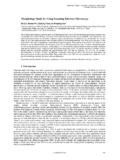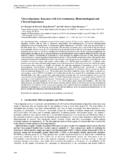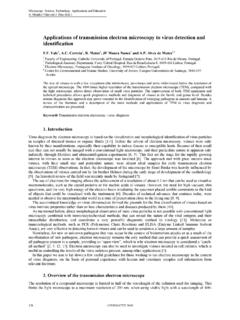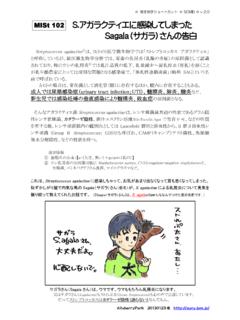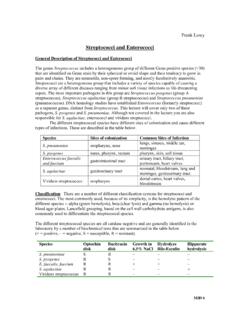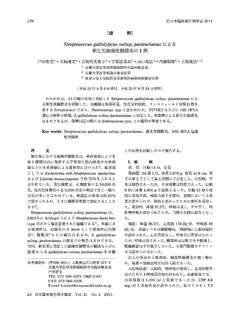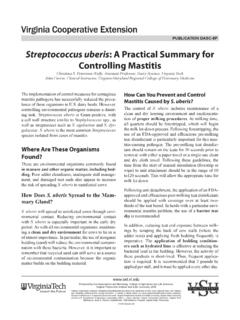Transcription of Antimicrobial susceptibility of Streptococcus agalactiae ...
1 Science against microbial pathogens: communicating current research and technological advances _____. A. M ndez-Vilas (Ed.). Antimicrobial susceptibility of Streptococcus agalactiae isolated from pregnant women in Misiones, Argentina M. Quiroga1, E. Pegels1, P. Oviedo1, M. Laczeski1, M. Vergara1. 1. C tedra de Bacteriolog a. Facultad de Ciencias Exactas, Qu micas y Naturales. Universidad Nacional de Misiones. Avda. Mariano Moreno 1375, 3300, Posadas, Misiones, Argentina. Streptococcus agalactiae or Group B Streptococcus (GBS) is the leading cause of neonatal infections. The aims of this study were to determine the susceptibility patterns of GBS infection in Misiones, Argentina. To this end, 3125 pregnant women were studied between 2004 and 2010, and 293 GBS strains were identified.
2 A total of 96 GBS strains were randomly selected for in vitro susceptibility testing. No resistance to penicillin, ampicillin, quinupristin-dalfopristin, and vancomycin was found. High-level resistance to gentamicin was not detected in any of the rate of resistance to erythromycin ( ) was higher than that reported previously in Argentina. The identification of resistant strains in this study suggests that these agents should be used with caution in the prophylaxis or treatment of GBS infection. The knowledge of the most prevalent phenotypes in our region is essential to carry out appropriate surveillance and appropriate procedures for the control and prevention of GBS infection. Keywords: Group B streptococci; Antimicrobial susceptibility ; macrolides; phenotype; pregnant women.
3 1. Introduction Group B Streptococcus (GBS) continues to be an important cause of infection and of significant morbidity and mortality in newborns and pregnant and non-pregnant women. Infants acquire GBS in utero by the ascending route through ruptured or intact membranes or during the birth process [1]. With the specific objective to prevent the early onset of GBS disease in the neonate, the Centre for Disease Control and Prevention (CDC) [2] recommended two strategies to identify mothers colonized with GBS. The strategies consist in identifying important maternal risk factors (previous child with invasive GBS disease, GBS bacteriuria during this pregnancy, delivery at <37 weeks' gestation, intrapartum temperature 38 C, membrane rupture 18 hours) or carrying out routine cultures of anogenital swabs in pregnant women at 35-37 weeks of gestation.
4 If colonization is detected, an antibiotic prophylaxis during delivery is recommended, since it may effectively prevent transmission of GBS to the newborn. In most cases, this prophylaxis results in a significant decrease in invasive neonatal GBS infections [3]. In our country, the search for GBS in all pregnant women with gestational age between weeks 35 and 37, who either present or not risk factors, has been obligatory by Law N 26369 for the entire nation since April 2008 ( - 2008). Penicillin G or ampicillin is still the drug of choice for prevention of perinatal GBS disease and erythromycin and clindamycin are recommended as treatment for women who are penicillin-intolerant. The widespread use of antibiotics carries the potential for emergence of antibiotic resistance.
5 Recent reports of the increasing incidence of macrolide and clindamycin resistance in different countries have raised concerns about the possibility of inadequate prophylaxis or treatment with these antibiotics. The purpose of this study was to determine the susceptibility patterns of GBS in a population of pregnant women in Misiones, a province situated in the northeaster of Argentina, which limits with Paraguay and Brazil. 2. Materials and methods A total of 3125 pregnant women between 35 and 37 weeks of gestation were enrolled in the study between 2004 and 2010. Vaginal-rectal swabs were collected without speculum and then placed in Stuart transport medium (Ventura Transystem- Medica-Tec Argentina) and transported to the laboratory at room temperature for microbiology analysis.
6 Swabs were incubated in a selective Todd-Hewitt broth containing colistin (10 g/ml) and nalidixic acid (15 g/ml). (Laboratorios Britania-Argentina) for 18-24 hours before subculture onto sheep blood agar plates (Agar Columbia- Laboratorios Britania Argentina) for 18-24 hours at 37 C with 5% CO2. If GBS was not identified after the incubation for 18-24 hours, the blood agar plates were reincubated and examined at 48 hours to identify suspected organisms. GBS strains were identified by biochemical standard methods. GBS identification was completed by group B- specific latex agglutination (Phadebact Strep B Test- ETC International-Bactus AB-Sweden). Serotypes were detected using Strep-B Latex (Statens Serum Institut, Denmark) for the identification of the capsular polysaccharide antigens Ia, Ib, II, III, IV, V, VI, VII, VIII and IX, according to the manufacturer s instructions.
7 444 FORMATEX 2011. Science against microbial pathogens: communicating current research and technological advances _____. A. M ndez-Vilas (Ed.). A total of 96 GBS strains, randomly selected for in vitro susceptibility testing to penicillin G, ampicillin, tetracycline, levofloxacin, gatifloxacin, quinupristin-dalfopristin, vancomycin, were tested using microdilution panels (MicroScan, Dade Behring Inc, USA). The isolates were considered susceptible or resistant according to the MIC breakpoints recommended by the Clinical and Laboratory Standards Institute (CLSI) [4]. The MIC of gentamicin (Bag , Argentina) was determined by the agar dilution method according to the guidelines of the CLSI. High-level resistance to gentamicin was defined as a MIC of 500 g/ml.
8 A total of 112 strains with an erythromycin-resistant phenotype were determined by the double-disk diffusion method with disks containing erythromycin (15 g) and clindamycin (2 g) from Laboratorios Britania, Argentina, onto sheep blood agar plates (Agar Mueller -Hinton Biokar, France) for 18-24 hours at 37 C with 5% CO2. Different phenotypes of macrolide-lincosamide-streptogramin B (MLSB) resistance were recognized in accordance with the description of Sepp l et al. [5] and CLSI recommendations [4]. Inducible clindamycin resistance by erythromycin was detected by a blunting of the clindamycin zone closest to the erythromycin disk, giving the appearance of a D (phenotype iMLSB). Resistance to clindamycin (confirmed by the agar dilution method) with no blunting of the clindamycin inhibition zone indicated constitutive resistance (cMLSB).
9 The M phenotype was characterized by susceptibility to clindamycin with no blunting of the inhibition zone around the clindamycin disk. 3. Results All GBS were susceptible to penicillin G, ampicillin, quinupristin-dalfopristin, and vancomycin. Of the isolates examined, % were susceptible to clindamycin, % to erythromycin, % to tetracycline, to gatifloxacin and % to levofloxacin. The rank order of susceptibility for GBS for the quinolones was: gatifloxacin ( %) > levofloxacin ( ). The gentamicin MIC ranged from 2 to 256 g/ml (MIC90 = 64 g/ml and MIC50= 8 g/ml). High-level resistance to gentamicin was not detected in any of the isolates. Among the 112 isolates, % was resistant to clindamycin and to erythromycin.
10 Among the erythromycin- resistant isolates, nine displayed the cMLSB resistance phenotype, two the iMLSB resistance phenotype, and two the M. resistance phenotype. Six of the thirteen erythromycin-resistant strains belonged to serotype Ia, four to serotype III, two to serotype II and one to serotype V. 4. Discussion The antibiotics tested in this study were those that are considered to have potential clinical utility for the treatment and prophylaxis of streptococcal infections and, therefore, have susceptibility breakpoints recommended by the CLSI [4]. GBS is sensitive to many Antimicrobial agents, especially -lactam antibiotics. Penicillin G and ampicillin are the Antimicrobial agents extensively used against SGB.
